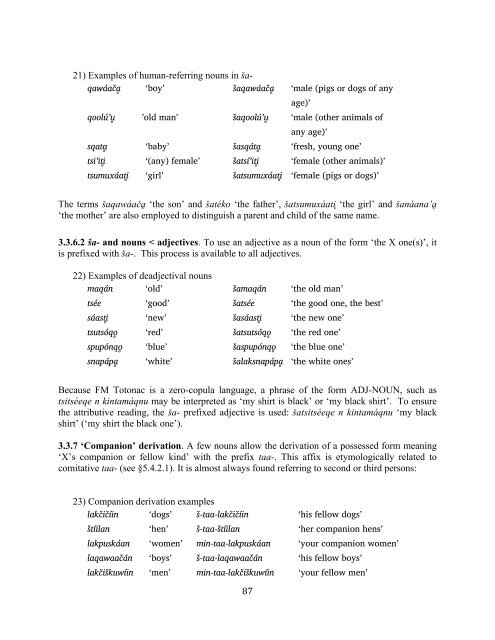The phonology and morphology of Filomeno Mata Totonac
The phonology and morphology of Filomeno Mata Totonac
The phonology and morphology of Filomeno Mata Totonac
Create successful ePaper yourself
Turn your PDF publications into a flip-book with our unique Google optimized e-Paper software.
21) Examples <strong>of</strong> human-referring nouns in #a-<br />
qawáac%a& ‘boy’ s%aqawáac%a& ‘male (pigs or dogs <strong>of</strong> any<br />
! ,+!<br />
age)’<br />
qoolú’u& 'old man' s%aqoolú’u& ‘male (other animals <strong>of</strong><br />
any age)’<br />
sqata& ‘baby’ s%asqáta& ‘fresh, young one’<br />
tsi’iti& ‘(any) female’ s%atsí’iti& ‘female (other animals)’<br />
tsumuxáati& ‘girl’ s%atsumuxáati& ‘female (pigs or dogs)’<br />
<strong>The</strong> terms #aqawáa$! ‘the son’ <strong>and</strong> #atéko ‘the father’, #atsumuxáati" ‘the girl’ <strong>and</strong> #anáana’!<br />
‘the mother’ are also employed to distinguish a parent <strong>and</strong> child <strong>of</strong> the same name.<br />
3.3.6.2 #a- <strong>and</strong> nouns < adjectives. To use an adjective as a noun <strong>of</strong> the form ‘the X one(s)’, it<br />
is prefixed with #a-. This process is available to all adjectives.<br />
22) Examples <strong>of</strong> deadjectival nouns<br />
maqán ‘old’ s%amaqán ‘the old man’<br />
tsée ‘good’ s%atsée ‘the good one, the best’<br />
sáasti& ‘new’ s%asáasti& ‘the new one’<br />
tsutsóqo& ‘red’ s%atsutsóqo& ‘the red one’<br />
spupónqo& ‘blue’ s%aspupónqo& ‘the blue one’<br />
snapápa& ‘white’ s%alaksnapápa& ‘the white ones’<br />
Because FM <strong>Totonac</strong> is a zero-copula language, a phrase <strong>of</strong> the form ADJ-NOUN, such as<br />
tsitséeqe n kintamáqnu may be interpreted as ‘my shirt is black’ or ‘my black shirt’. To ensure<br />
the attributive reading, the #a- prefixed adjective is used: #atsitséeqe n kintamáqnu ‘my black<br />
shirt’ (‘my shirt the black one’).<br />
3.3.7 ‘Companion’ derivation. A few nouns allow the derivation <strong>of</strong> a possessed form meaning<br />
‘X’s companion or fellow kind’ with the prefix taa-. This affix is etymologically related to<br />
comitative taa- (see §5.4.2.1). It is almost always found referring to second or third persons:<br />
23) Companion derivation examples<br />
lakc%ic%íin ‘dogs’ s%-taa-lakc%ic%íin ‘his fellow dogs’<br />
s%tíilan ‘hen’ s%-taa-s%tíilan ‘her companion hens’<br />
lakpuskáan ‘women’ min-taa-lakpuskáan ‘your companion women’<br />
laqawaac%án ‘boys’ s%-taa-laqawaac%án ‘his fellow boys’<br />
lakc%is%kuwíin ‘men’ min-taa-lakc%is%kuwíin ‘your fellow men’

















